By Jeffrey A. Rendall, Photos By Jeffrey A. Rendall and Chuck Rendall
|
|
BANDON, OR – It’s never easy when following in someone’s footsteps, and doubly hard when the imprints are made by large and successful feet. It’s almost like playing quarterback on a college team the year after a Heisman Trophy winner… or being the ‘mop up’ band after the Rolling Stones leave for the backstage party.
This ‘big shoes to fill’ scenario confronted the design team of Coore & Crenshaw at Bandon Dunes -- tagged to scribe the famous golf resort’s third golf course, Bandon Trails. There’s always pressure in laying out a golf course at a place where golf is highly respected, but when you’re following in the wake of two existing courses (Bandon Dunes and Pacific Dunes) at a ‘legend’ like Bandon Dunes, it can be an awful burden to bear.
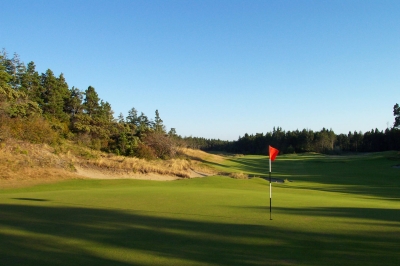 |
| Looking back from the par four 15th hole's green. Immediately you notice the change in appearance from the seaside courses, though the links 'feel' is still very much in evidence at Bandon Trails. |
Bill Coore shares the headlines in his company’s design team (along with two-time Masters Champion and Ryder Cup Captain extraordinaire Ben Crenshaw), and he says that while it was quite an honor to get the third course job at Bandon Dunes, it also brought some apprehension: “Ben and I were well aware of the first two courses at Bandon, how good they were reported to be. Oftentimes with publicity, one never really knows how good something truly is – but after having been out there, and seeing the courses, and playing them, we realized that Bandon deserved all its accolades.”
Coore continues, “Bandon’s truly an extraordinary place, a gift for golf. And the fact that it’s public… just makes it all the more appealing. So when Mike Keiser called to see if we’d be interested in working there, needless to say, we were flattered. But it was kind of a combination of excitement and apprehension – thinking, ‘boy, we’ve got a tall order here,’ just to build something that would be perceived as a compliment to what’s already there.”
Coore said that in the golf business, you always want to work where the best have been, whether it’s following in the path of the best architects, or the best examples of golf architecture -- and they felt Bandon Dunes was an illustration of both of those. Sure, it was still in its infancy in a temporal sense, having only been operating since 1999 (with the opening of the original Bandon Dunes course, designed by David McLay Kidd), but the unique concept adopted along the hundred-foot cliffs and rocky shoreline of Central Oregon had already earned Bandon Dunes much notoriety and praise.
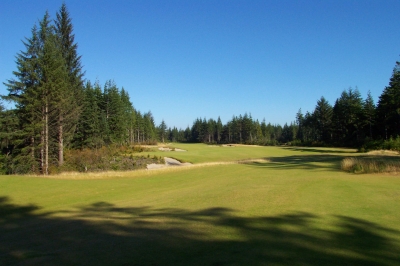 |
| With Bandon Trails' hard and fast playing conditions, the par five 9th hole is certainly reachable in two if you can shape your shots and run it along the ground. |
Such a dilemma’s enough to make your knees knock with nerves, though two gentlemen calling Texas home would never own up to being ‘fraid of a challenge.
The fact that Coore and Crenshaw had known Keiser for years must’ve eased some of the anxiety. A long standing relationship never hurts when you’re trying to create something new, yet also ‘compliment’ what’s already there.
“Our goal was to build a course that was perceived as a compliment to the other two,” Coore confirmed. “We never went there to compete, in the sense where ‘oh, we’re going to build a course that’s going to be highly regarded, or ranked in somebody’s listing, or anything else,’ as the other two courses had been. We wanted to design something that, if you went out there to play three rounds of golf – and they told you that one of the rounds was scheduled at Bandon Trails – that you wouldn’t be disappointed. We wanted you to be excited about that.”
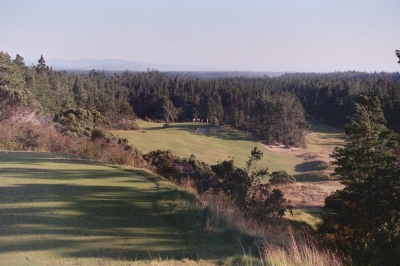 |
| It's quite a hike from the 13th green to the 14th tee -- so take a minute to stop and admire the view... and catch your breath. |
I know we were. It was the first Coore & Crenshaw layout we’d ever played, having only heard about (and seen on TV) their work on the Plantation Course at Kapalua (home of the annual Mercedes Championships) and also their very highly regarded (and private) projects at places such as Sand Hills and Cuscowilla. They’d compiled a more than solid resume of design accomplishments, so being placed alongside Tom Doak (Pacific Dunes’ architect) and Kidd seemed like a natural progression of architects with reputations for distinctive work.
John Grothe, Bandon Dunes’ Director of Golf, was there to witness the building of Bandon Trails, and he reiterated that Mr. Keiser wanted something different with the new course, but also something that would fit within the unique scheme of the resort: “When we were in the planning stages for Bandon Trails, we already had two great links golf courses along the ocean. The property also contained this wonderful land that wasn’t right on the water, but had the same great sand base as the others and was highly suited for golf – so Mr. Keiser wanted to bring somebody in to design a different kind of golf course, but also one that wouldn’t go outside what we already had.”
“He (Keiser) wanted another eighteen holes that wouldn’t feel redundant – and he thought he’d try to create something in the mold of some classic courses like Pine Valley or Royal Melbourne (in Australia). He didn’t have any specific holes in mind, but to kind of keep that theme, and maybe when you walk around the golf course, you’ll say ‘hey, this reminds me of someplace.’ That was his inspiration,” Grothe added.
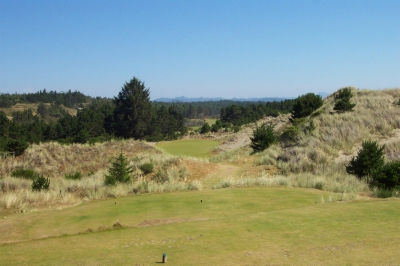 |
| The first few holes are set in the dunes that have made Bandon famous for golf. From the tee of the par three 2nd hole, it looks like there's very little room to hit to -- but unless you're far to either side, you're probably okay. |
Standing on the first tee, Bandon Trails certainly reminded us of someplace, though we couldn’t quite place it. It looked like a rolling dunes landscape with green targets in the distance. Truly, if there was ever a setting where a golf course looked like it was always there, this was this place. The appearance was a bit intimidating, but definitely included the forces of nature working in your favor.
Grothe said Keiser chose Coore & Crenshaw because he was familiar with their work, but perhaps more importantly, because of the kind of people that Bill and Ben are. Their reputation for hands-on, hand-crafted golf courses along with easy-going personalities was also a continuation of the successful Bandon Dunes model utilized in creating the first two layouts.
In other words, Keiser didn’t want the designers’ personalities to get in the way of the golf. And Coore and Crenshaw said it worked both ways.
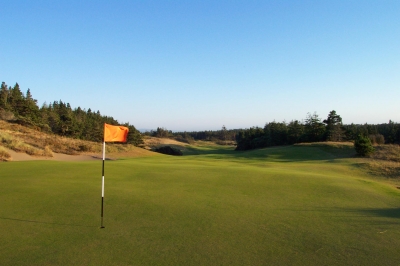 |
| Once you've reached the green of the par five 16th hole, you've played some golf to get there. Bandon Trails' #2 handicap hole, though it probably ranks number one in a lot of peoples' books. |
“Lord knows, Ben and I have both said so many times – is all you can ask for of an owner is to be given a gifted site with which to work, and then the freedom to work with it. Mike did that, from both perspectives,” Coore said.
Freedom being the crucial element. Keiser originally envisioned a golf course solely amongst the wooded portion of the resort. But as soon as Coore & Crenshaw arrived on scene, they saw it differently, and set towards convincing the owner that a little topographical variety was really the best way to achieve the goal of complimenting the other courses.
Again, Coore supplies the details. “When Mike called, his first conception of the new golf course was that it would be amongst the trees. I said ‘okay, is it sandy?’ And he said yes. So we went out to look – and certainly the woodlands section is very attractive, but it just seemed to us that the other parts of the property that now comprises the golf course, both the dunes and what we refer to as the ‘meadow area’ -- it just cried out to be part of Bandon Trails.”
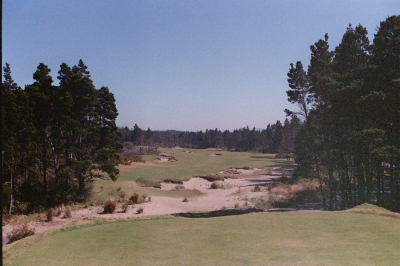 |
| The par five 3rd hole begins the transition from dune to meadow land. Just like 'real' links golf, the fairway's contoured to help you along -- this is where local knowledge will definitely help. |
“Besides, the fact that the resort is named for dunes… so therefore, we felt there was a way to unify the entire project and start and finish the golf course in the big dunes, and travel through the meadow, then out to the woodlands section – and showcase all three,” Coore remembered.
The challenge involved in incorporating such diverse types of terrain was to put it all together in one golf course and not have it look or feel disjointed, or to have one section ‘wow’ you, only to have the other holes merely pushing you along.
“Mike was very supportive of the idea,” Coore continued. “His comments were, ‘well, if you think you can do it in a seamless enough fashion to where there isn’t any disappointment when you travel from one part to the other, then I’m all for it.’ So we spent some time laying out the holes and walked the lay of the land with him, until he got comfortable with it.”
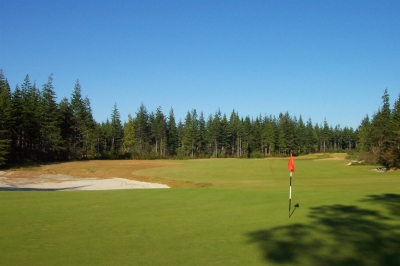 |
| Wide and unassuming, the par four 10th hole still requires the strategic play to give yourself a decent birdie try, according to John Grothe. |
Rare it is when you can have a golf course with as many different settings and still maintains some semblance of continuity, but Bandon Trails has it. Holes 1-2 are amongst the dunes, 3-6 move across the meadow, then 7-13 have more of a mountain/parkland feel. Finally, after a bit of a hike to the fourteenth tee, you have 14-16 with the meadow theme, and conclude with the seventeenth and eighteenth holes surrounded by dune-land.
The course still plays the same all throughout, so you won’t get a migraine trying to separate one strategy from the next. Bandon Trails is a resort course first, with wider than average playing areas, together with the resort’s unique ‘links’ playing conditions – hard surfaces with a lot of roll, designed to be played closer to the ground.
And despite being an up-and-down journey, Bandon Trails remains highly walk-able, with only the previously mentioned ‘hike’ between the thirteenth green and fourteenth tee requiring a bit of a breathless pause between shots.
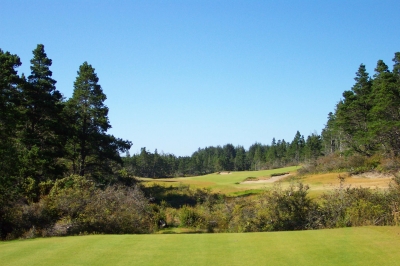 |
| The tee of the par four 6th hole reveals one of Bandon Trails' secrets -- it looks like there's a lot of trouble out there, but for the average player, there's plenty of room to go 'round. |
For his opinion, Grothe says the walking concept on the Trails golf course is essential, as it is for all of the golf at Bandon Dunes. “When you think about it, how can you put a walking-only facility in the middle of nowhere, in Oregon, and hope for it to succeed? The funny thing is, the walking-only component (along with caddies) can’t be separated from our success -- they’re one and the same.”
“Because I think if we put the typical resort, spa, golf, carts and cart paths – the whole thing – if we went the usual corporate route, we’d lose most of our distinction. The fact you must walk here makes Bandon Dunes really stand out in the minds of people saying ‘this is what this place is all about,’” Grothe added.
The ‘about’ part meaning the complete absence of artificial distractions. Bandon Dunes means you and nature… nature and you. Like the benches on the courses are carved from driftwood. There aren’t any big, ugly marble tablets for hole markers, either – they’re in the ground. The tee markers are natural and even the bathrooms are hidden.
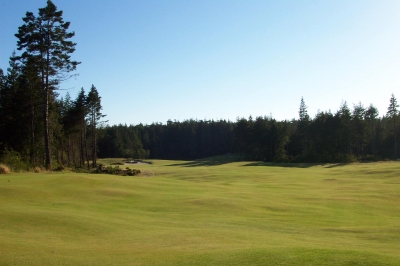 |
| In Bandon Trails' wooded section, you'd never know you're just a stone's throw away from the ocean. It's this variation in terrain that really sets this course apart. |
“All the ‘natural’ elements combine to where you don’t know where you are, and you don’t know when you are, either,” Grothe hypothesized. “You’re out there, and it could be the fifties, or it could be the 1800’s. You could be in Scotland or Ireland, or anywhere in the world, and yet, you still get to be at a fantastic resort that has all the amenities that you could ever want.”
While the walking part is great (on all three courses), we’re offering some suggestions before going to Bandon Dunes (see below, in the ‘details’ section).
Once on the course, as alluded to above, Bandon Trails plays very friendly. From the back tees, some of the tee shot carries are lengthy and very demanding, but as long as you can hit it a certain distance and reasonably straight, the landing areas are exceedingly generous. Grothe correctly points out that many of Trails’ holes are lined by trees, but they don’t really come into play unless you’re having a particularly crooked day.
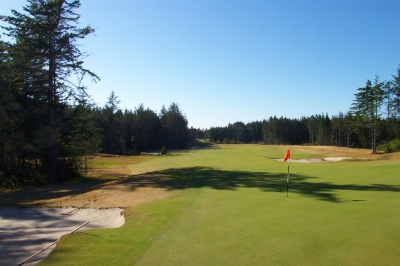 |
| Trees line the 7th hole's fairway, though they really don't come into play. In this way, the course maintains its playing continuity from dunes to meadow to woodland without confusing anyone. |
He describes the ‘theme’ behind the strategy: “I really think Bandon Trails rewards good shots, as a well thought-out golf course should. Coore & Crenshaw did a great job of making it a resort course first – they understood that obviously most people playing it are bogey golfers or above. And for them, it needs to be an enjoyable experience, just as it needs to be an interesting test for better players.”
“So it’s pretty easy to make a par or a bogey, and the bogey player is going to have a generous landing area off the tee and around the greens – where they’ll be able to finish the hole with a decent chance at two-putting. The better player will need to challenge the hazards off the tee in order to set-up the best angles into the greens, and then make some putts,” Grothe concluded.
Sounds pretty simple. But in the end, golf doesn’t have to be difficult, at least in the conceptual way of thinking. Coore and Crenshaw went out of their way to provide a course where everyone will take something away from it -- if only the experience of playing something different at Bandon Dunes, enjoying a new kind of beauty, and a scenic variety you won’t get on the other courses.
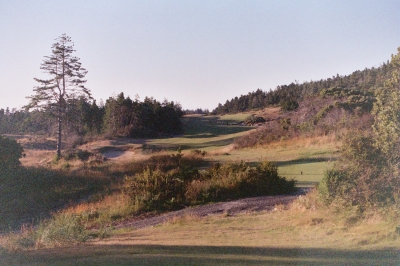 |
| Shadows and shrub obscure the tee view of the par five 16th hole. Pick your target and trust the ball will find a safe spot. |
All and all, about as fine a ‘compliment’ as you’ll ever ask for.
Note: Check the ‘details’ section below for notes on accommodations, meals and caddies.
Details:
The Bandon Trails Course at Bandon Dunes Golf Resort
Website: http://www.bandondunesgolf.com/
Phone: (541) 347-4380; Toll Free (888) 345-6008
Designers: Bill Coore and Ben Crenshaw
Owner and Visionary: Mike Keiser
Director of Golf: John Grothe
Tees/Yardage/Slope/Rating – Scorecard values
Black 6765 130/73.4
Green 6260 135/70.9
Gold 5731 123/69.0 (L) 134/74.7
Orange 5064 120/70.6
Rates and Notes:
Rates range from $70 - $175 (for hotel guests) and $90 - $225 (for non-hotel guests), depending on time of the year – and are also tied into packages based on hotel stays and duration of visit. Consult the website for further details.
Fees include all the range balls you’ll ever want, and access to Bandon Dunes’ 60-acre practice facility (designed by David McLay Kidd).
Carts not included! Pull carts are available, however (for no charge). We would not recommend anything other than carrying your bag or taking a caddy, however. All of Bandon’s courses are somewhat challenging to navigate, and the on-course marshals will keep you moving. They’ll switch over your huge cart/travel bag to a carrying bag upon request, and this is highly recommended. ‘Dragging’ the pull carts through the sand at Bandon Dunes is an ‘exercise’ in frustration as well as a thorough workout for your body. Not for the less than hearty.
We did not stay onsite, or try any of the restaurants (we stayed in town and enjoyed the local offerings when not golfing) – however, we heard good things about both, including from the wife of a playing partner. Bandon Dunes is not your ultimate family vacation (at least with young children), and that should be taken into account when booking a trip there. If you’re there to play golf, there’s hardly anything better in the world – but for non-golfers, the pickings are somewhat sparse.
Consult the website for more information on accommodations and possible alternative attractions.
The Bandon Dunes staff was first-rate – everything you’d expect for this type of ‘pure’ experience. The resort and its golf are not inexpensive, but you’ll feel there’s good value there.
| Related Links | Comments on this article? | |
|
Maryland National Golf Club Hollow Creek Golf Club Rocky Gap Resort PB Dye Golf Club in Ijamsville Whiskey Creek Golf Club |
E-mail Jeff Rendall, Editor: jrendall@golftheunitedstates.com |












